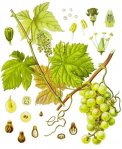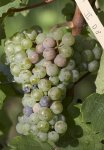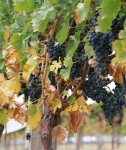Grapes cultivated - vitis vinifera l.
Family of grapes (Vitaceae).
Botanical characteristics. Crawling bush with a thick trunk and long antennae on branches. Leaves alternate, petiolate, round or rectangular, deeply 3 - 5 - 7 lobed, less often holistic. Flowers are bisexual, sometimes same-sex, collected in racemose inflorescences. Fruit - fleshy juicy berry of various forms and colors, from yellow-green to black-violet. The berries are collected in a brush. Blooms in May - June. Ripens in August - September.
Spread. Grapes are cultivated by man for at least 8 to 9 thousand years. Archaeologists in the territories of France and Italy found fossil remains of grapevines related to the Quaternary period, and in Switzerland - seeds of the Tertiary period.
Ancient Greek legend tells about the appearance of grapes. God Dionysus once decided to make a gift to his pet Ampel. Get it Ampel was, climbing on a high elm, in order to demonstrate their agility and strength. But the young man crashed, falling from the tree. And distressed Dionysus decided to perpetuate the memory of Ampel: his body became a vine.
In the XVI century. Grapes from France were imported to the American continent. Approximately at the same time the plant began to be cultivated on the territory of Armenia, Crimea. In the XVII century. The "grape garden" was laid for the first time in the Moscow region, and the vines were buried with earth for the winter. In the reign of Peter I the grapes were grown on the Don.
Chemical composition. Grape berries contain glucose, sucrose, organic acids (malic, tartaric), pectin, tannins, amino acids, flavonoids, anthocyanins, aromatic substances, sterols, catechins, ascorbic acid, B, P, PP, folic acid, carotene, salts Potassium, calcium, magnesium, iron, cobalt, manganese.
In the leaves are found sugars, organic acids, inositol, tannins, quercetin, carotene, betaine.
Application. In folk medicine use ripe berries and leaves of grapes. The leaves are harvested in May or October, preference is given to those that die during dying.
Indications for the use of grapes are very extensive.
However, in diabetes mellitus it is very strictly necessary to dose the use of berries and it is absolutely counter-indicative to drink grape juice.
Grapes are useful for anemia, radiation sickness, depletion of the nervous system, liver diseases, spastic and atonic constipation, nephritis, kidney stone disease, hemorrhoids, and pulmonary tuberculosis. Decoction of dried fruits facilitates the processes of expectoration, a good diuretic, and the infusion of leaves lowers blood pressure.
Preparation
- Powder from the leaves of the grape cultural. Dry leaves are ground into powder and take 1 - 2 g 3 times a day for bleeding, profuse menstruation.
- Infusion of grape leaves cultural. 1 tbsp. L. Dry crushed leaves pour 1 cup boiling water and insist 2 hours. Used to rinse the mouth with angina, diabetic periodontal disease.
- Decoction of dry berries of grapes (raisins). 30 grams of raisins pour 1 cup of boiling water and boil for 10 minutes. Insist 1 hour. Infusion with berries drink a third cup 3 times a day with heart and general weakness.
- Compresses made from fresh grape leaves. Young leaves are crushed and ground into a homogeneous mush. Apply to purulent wounds, boils, on bedsores, ulcers. After an hour, the skin is washed with boiled pure or soda water or a weak solution of potassium permanganate. Compresses and applications are repeated 7 to 10 times daily to clean or heal the wound surface.
Use of grapes in nutrition
Traditionally, grapes are considered a delicious dessert berry. In Moldova, the leaves of the plant are consumed in salads, for cooking cabbage rolls, stews, in combination with other vegetable components.
- Salad from young leaves.
Leaves are thoroughly washed in running water, cut into small strips and seasoned with sour cream, salt, add lemon juice or citric acid.
- Leaves of grapes - 100 grams,
- Sour cream - 15 - 20 g,
- salt,
- Citric acid to taste.
- Salad from the leaves of grapes, currant leaves and sorrel.
Leaves of grapes, currants and sorrel thoroughly washed, give water to drain and finely chop. Season with sour cream, salt and cumin.
- Leaves of grapes - 50 g,
- Black currant leaves - 40 grams,
- Leaves of sorrel - 30 grams,
- Sour cream - 20 grams,
- salt,
- Cumin to taste.
- Cabbage rolls.
Prepare carrots and minced meat for cabbage rolls. Young large leaves of the grapes are washed, blanched to moderate softening. Minced meat is wrapped in leaves and placed in a goose flesh, previously densely greasing the walls with fat. Add a small amount of water or broth and stew. Before the end of cooking pour sour cream and tomato sauce and bring to a boil, turn off, let it brew for 1 hour. Serve with sour cream.
- Leaves of grapes - 200 grams,
- Minced meat - 200 grams,
- Carrots - 50 grams,
- Onion - 30 g,
- Sour cream - 20 grams,
- Tomato sauce or pasta - 20 grams,
- Fat culinary - 30 grams,
- salt,
- Spices to taste.






Comments
When commenting on, remember that the content and tone of your message can hurt the feelings of real people, show respect and tolerance to your interlocutors even if you do not share their opinion, your behavior in the conditions of freedom of expression and anonymity provided by the Internet, changes Not only virtual, but also the real world. All comments are hidden from the index, spam is controlled.